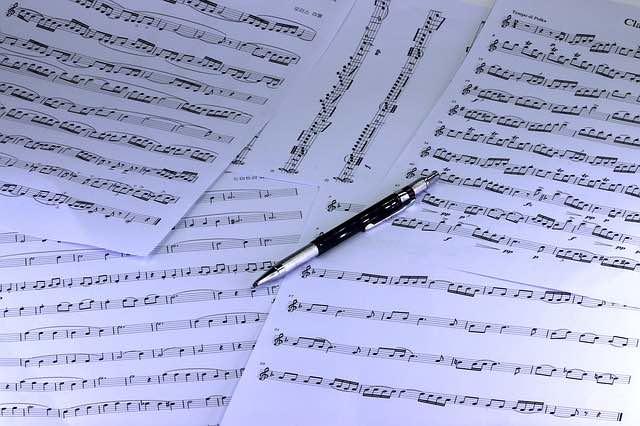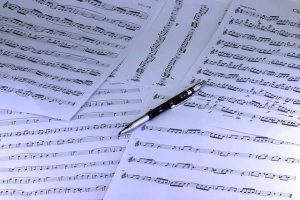Students often ask about the difference between major and minor. These terms have two applications in music theory. One use relates to chords (harmony). A second use relates to scales (modes). Both are related.
To understand these concepts deeper, you have to first understand intervals. An interval is the space between two notes. Intervals help to define the relationship and interaction between notes. This also includes the formation of chords.
Third Intervals
The smallest interval in music is a half step. Half steps on the piano are keys located next to one another. Most of the time, this will mean moving from a white key to a black key (or vice versa). However, half steps also occur between “B” and “C” and “E” and “F” on the white keys.
Major and minor chords are defined by a third interval between the root (bottom or lowest pitch of a chord) and another higher pitch. But if you don’t know how to find the third, or if you often confuse a major third with a minor third, you can count half steps as a failsafe.
Here’s how you would count half steps to find major and minor thirds:
- A major chord contains 4 half step intervals between the root of the chord (bottom note) and the third (top note).
- A minor chord contains 3 half step intervals between the root of the chord (bottom note) and the third (top note).
Let’s look at some examples. First, let’s find a major third using “C” as our root. If we follow the rules spelled out above, we need to find 4 consecutive half steps.
In this example, they are as such:
1.) C to C-sharp (1st half step)
2.) C-sharp to D (2nd half step)
3.) D to D-sharp (3rd half step)
4.) D-sharp to E (4th half step)
For a minor third, we would count only 3 half steps:
1.) C to D-flat (1st half step)
2.) D-flat to D (2nd half step)
3.) D to E-flat (3rd half step)
The correct enharmonic spelling of note names plays a role in how we count steps too. For example, flats are used in the minor third example above because we must land on a third interval.
Technically, “C” to “D-sharp” (although it sounds the same on the piano as “C” to “E-flat”) is an augmented 2nd. It is a 2nd because the letters “C” and “D” are consecutive. Consecutive letters = 2nd intervals. Moreover, adding a sharp to the “D” only qualifies this letter; it doesn’t fundamentally change the name. On the other hand, “C” to “E,” and “C” to “E-flat” both equal three steps. Once again, “C” to “E” is a major third, while “C” to “E-flat” is a minor third.
Usually, major and minor chords also contain a perfect fifth interval between the root and the fifth. This makes the chord a triad. However, the fifth is optional, and it does not define the chord. If you add the perfect fifth but take away the third, major and minor triads will sound identical. The fifth merely adds density to the chord. Note: This does not apply to diminished or augmented triads, which include altered fifths.
Major or Minor – it’s One or the Other!
Major and Minor make up the two sides of the proverbial coin when it comes to defining the key of a song or composition. Songs are either in a major key or a minor key. Sometimes more complex songs or pieces contain modulations (key changes), and we may see both major and minor keys represented in a single work. However, major and minor keys (and their correlating modes) cannot occur at the same time, at least in tonal music. Each piece, or section of a piece, must be either major OR minor. They cannot be both.
Happy or Sad?
Sometimes people say that major is “sunny” or “happy,” while minor is “dreary” or “sad.” There is some truth to this. However, there are plenty of examples that belie this too. For example, REM’s “Everybody Hurts” is a “sad” song, yet its key is D major. Adele’s heart-rending “Someone Like You” is also major.
Conversely, the upbeat “My Favorite Things” from The Sound of Music is in E minor. Similarly, Peggy Lee’s passionate “Fever” is also, perhaps surprisingly, minor. There are many other examples of songs that don’t fall into the “major is happy” or “minor is sad” categories.
Songs and Scales – They are Related
Major and minor-keyed songs are based on their corresponding scales (modes). This informs both the content of the melody and the harmony of a piece.
In other words, major-keyed songs cull from notes found in a specific seven note major scale (like C major or F major, etc.). Minor-keyed songs cull from seven-note minor scales (like C minor or F minor, etc.). With minor, however, there is one parent minor scale called the natural minor, plus two variants called the harmonic and melodic minor, respectively.
Further, major and minor chord progressions usually follow the primary cadences (harmonic touchstones) of the mode they are derived from. Major keyed pieces almost always end on a major “home base” chord too. This chord is usually called a “I,” using Roman numerals.
The reverse is true with minor-keyed songs. Occasionally, however, minor keyed classical pieces surprise the listener by suddenly ending with a major third in the “home base” or “I” chord. This unexpected switcheroo gives the music a sudden lift. The classical term for this is picardy third.
Play and listen to major and minor triads, as well as major and minor scales, to hear the different types of moods and flavors that each invokes.
Eric Starr

